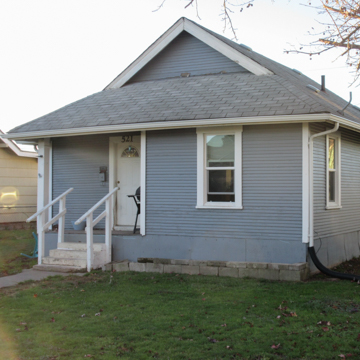You are here
Saint Helens Worker Cottage
The Long-Bell Lumber Company recognized early in the development stage of Longview that providing low-cost housing for married workers would be challenging for private builders, who erected the bulk of single-family houses and apartment buildings in the new city. As a consequence, the Long-Bell Lumber Company undertook the building of some 250 houses in the Saint Helens Addition south of Lake Sacajawea Park and west of Oregon Way. Not all remain in their original configuration, but a few—such as this one—provide excellent examples of the type that was built for this development. These were mostly single- or one-and-a-half-story wooden bungalows with shallow covered porches and gable, hipped, or jerkinhead roofs built atop a concrete foundation. There was little architectural embellishment.
As with other aspects of the lumber company’s construction projects in Longview, professional architects were hired to design the Saint Helens cottages. Long-Bell selected John R. Nevins Jr. and Schack, Young and Myers from Seattle as designers; the architects had also designed the nearby Saint Helens Inn dormitory complex and a number of early buildings in the city. Long-Bell, however, built the houses rather than contracting them to the Westlake Construction Company, as was the case with the other buildings. At the time, the Westlake Construction Company was working under a cost-plus contract, so the decision by Long-Bell was dictated by a need to keep costs as low as possible.
In most company-developed towns, worker housing was invariably owned by the company with the workers only allowed to rent. In Longview, the Long-Bell Lumber Company and R.A. Long himself did, in fact, retain ownership of some worker housing; however, the Saint Helens Addition cottages were intended for eventual sale. As such, the Saint Helens Addition presaged the large-scale tract-house development that would occur statewide after World War II. As with postwar tract housing, the Saint Helens Addition cottages attempted to create visual variety by providing different types of cladding, such as wood siding, clapboard siding, and wood shingles, and by employing a variety of roof forms within a small number of standardized floor plans.
Although most of the houses have been altered, often with new fenestration or cladding, a walk through the Saint Helens Addition still allows one to get a feel for the relatively simple massing and detailing that marked what originally was a large collection of worker houses. Although the much-altered house at 671 16th Avenue was the first of the cottages to be completed and occupied, aside from a rear addition, the house at 521 16th Avenue remains relatively unchanged on the exterior and provides a more accurate glimpse into the past. It appears only the front door has been replaced and a picture window installed on the west side.
Writing Credits
If SAH Archipedia has been useful to you, please consider supporting it.
SAH Archipedia tells the story of the United States through its buildings, landscapes, and cities. This freely available resource empowers the public with authoritative knowledge that deepens their understanding and appreciation of the built environment. But the Society of Architectural Historians, which created SAH Archipedia with University of Virginia Press, needs your support to maintain the high-caliber research, writing, photography, cartography, editing, design, and programming that make SAH Archipedia a trusted online resource available to all who value the history of place, heritage tourism, and learning.

